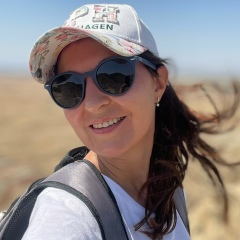Структура подложки определяет направление дифференцировки стволовых клеток
Американские ученые из National Institute of Standards & Technology исследовали влияние подложек с различной трехмерной структурой на культивируемые на них стволовые клетки.
При помощи скрининга ДНК было выявлено, что у первичных человеческих стромальных клеток костного мозга (СК КМ) каждый тип подложки индуцирует уникальный рисунок экспрессии генов. Было также обнаружено, что физическая структура подложки оказывает большее влияние на экспрессию генов, чем химический состав подложки.
Ученые открыли, что влияние структуры подложки на функцию СК КМ опосредовано изменением формы клеток.
Из всех протестированных подложек вызвать остеогенную дифференцировку СК в отсутствие химических остеогенных добавок в среде удалось только на подложке со структурой нановолокон. Нановолокна заставляли клетки принимать удлиненную и разветвленную форму. Такая морфология характерна для СК КМ, дифференцирующихся в остеобласты под воздействием химических остеогенных добавок при выращивании на плоской полимерной пленке. Напротив, культивируемые на плоской поверхности СК КМ в отсутствие остеогенных добавок имеют более округлую и неветвистую форму.
По мнению доктора П.И. Катуняна, главного врача московского Центра медико-биологических технологий, результаты данной работы говорят о том, что стволовые клетки гораздо более чувствительны к структуре подложки, чем считалось до сих пор. Значит, используя определенную структуру подложки, можно заставить стволовые клетки изменять форму и таким образом повлиять на направление их дифференцировки, чтобы получить клетки нужной ткани.
Материалы исследования представлены в статье Kumar G, et al. The determination of stem cell fate by 3D scaffold structures through the control of cell shape.
Американские ученые из National Institute of Standards & Technology исследовали влияние подложек с различной трехмерной структурой на культивируемые на них стволовые клетки.
При помощи скрининга ДНК было выявлено, что у первичных человеческих стромальных клеток костного мозга (СК КМ) каждый тип подложки индуцирует уникальный рисунок экспрессии генов. Было также обнаружено, что физическая структура подложки оказывает большее влияние на экспрессию генов, чем химический состав подложки.
Ученые открыли, что влияние структуры подложки на функцию СК КМ опосредовано изменением формы клеток.
Из всех протестированных подложек вызвать остеогенную дифференцировку СК в отсутствие химических остеогенных добавок в среде удалось только на подложке со структурой нановолокон. Нановолокна заставляли клетки принимать удлиненную и разветвленную форму. Такая морфология характерна для СК КМ, дифференцирующихся в остеобласты под воздействием химических остеогенных добавок при выращивании на плоской полимерной пленке. Напротив, культивируемые на плоской поверхности СК КМ в отсутствие остеогенных добавок имеют более округлую и неветвистую форму.
По мнению доктора П.И. Катуняна, главного врача московского Центра медико-биологических технологий, результаты данной работы говорят о том, что стволовые клетки гораздо более чувствительны к структуре подложки, чем считалось до сих пор. Значит, используя определенную структуру подложки, можно заставить стволовые клетки изменять форму и таким образом повлиять на направление их дифференцировки, чтобы получить клетки нужной ткани.
Материалы исследования представлены в статье Kumar G, et al. The determination of stem cell fate by 3D scaffold structures through the control of cell shape.
The structure of the substrate determines the direction of differentiation of stem cells
American scientists from the National Institute of Standards & Technology investigated the effect of substrates with different three-dimensional structure on stem cells cultured on them.
Using DNA screening, it was found that in primary human bone marrow stromal cells (SC KM), each type of substrate induces a unique pattern of gene expression. It was also found that the physical structure of the substrate has a greater influence on the expression of genes than the chemical composition of the substrate.
Scientists have discovered that the influence of the structure of the substrate on the function of the SC KM is mediated by changing the shape of the cells.
Of all the substrates tested, it was possible to induce osteogenic differentiation of SC in the absence of chemical osteogenic additives in the medium only on the substrate with the structure of nanofibers. Nanofibres forced cells to take an elongated and branched form. Such a morphology is characteristic of SC KM, which differentiate into osteoblasts under the influence of chemical osteogenic additives when grown on a flat polymer film. On the contrary, SC CM, cultivated on a flat surface, in the absence of osteogenic additives have a more rounded and non-branchy shape.
According to Dr. PI Katunian, chief physician of the Moscow Center for Biomedical Technologies, the results of this work suggest that stem cells are much more sensitive to the structure of the substrate than was thought until now. So, using a certain substrate structure, stem cells can be made to change shape and thus influence the direction of their differentiation in order to obtain cells of the desired tissue.
Research materials are presented in the article Kumar G, et al. 3D scaffold structure of the cell structure.
American scientists from the National Institute of Standards & Technology investigated the effect of substrates with different three-dimensional structure on stem cells cultured on them.
Using DNA screening, it was found that in primary human bone marrow stromal cells (SC KM), each type of substrate induces a unique pattern of gene expression. It was also found that the physical structure of the substrate has a greater influence on the expression of genes than the chemical composition of the substrate.
Scientists have discovered that the influence of the structure of the substrate on the function of the SC KM is mediated by changing the shape of the cells.
Of all the substrates tested, it was possible to induce osteogenic differentiation of SC in the absence of chemical osteogenic additives in the medium only on the substrate with the structure of nanofibers. Nanofibres forced cells to take an elongated and branched form. Such a morphology is characteristic of SC KM, which differentiate into osteoblasts under the influence of chemical osteogenic additives when grown on a flat polymer film. On the contrary, SC CM, cultivated on a flat surface, in the absence of osteogenic additives have a more rounded and non-branchy shape.
According to Dr. PI Katunian, chief physician of the Moscow Center for Biomedical Technologies, the results of this work suggest that stem cells are much more sensitive to the structure of the substrate than was thought until now. So, using a certain substrate structure, stem cells can be made to change shape and thus influence the direction of their differentiation in order to obtain cells of the desired tissue.
Research materials are presented in the article Kumar G, et al. 3D scaffold structure of the cell structure.
У записи 1 лайков,
0 репостов.
0 репостов.
Эту запись оставил(а) на своей стене Илья Клабуков






















